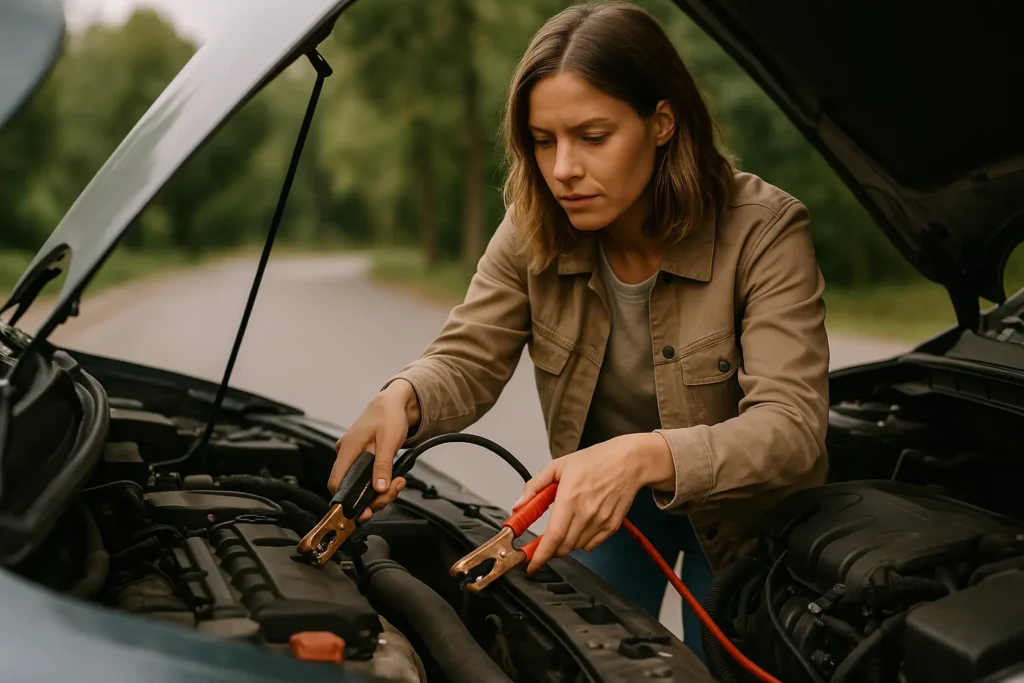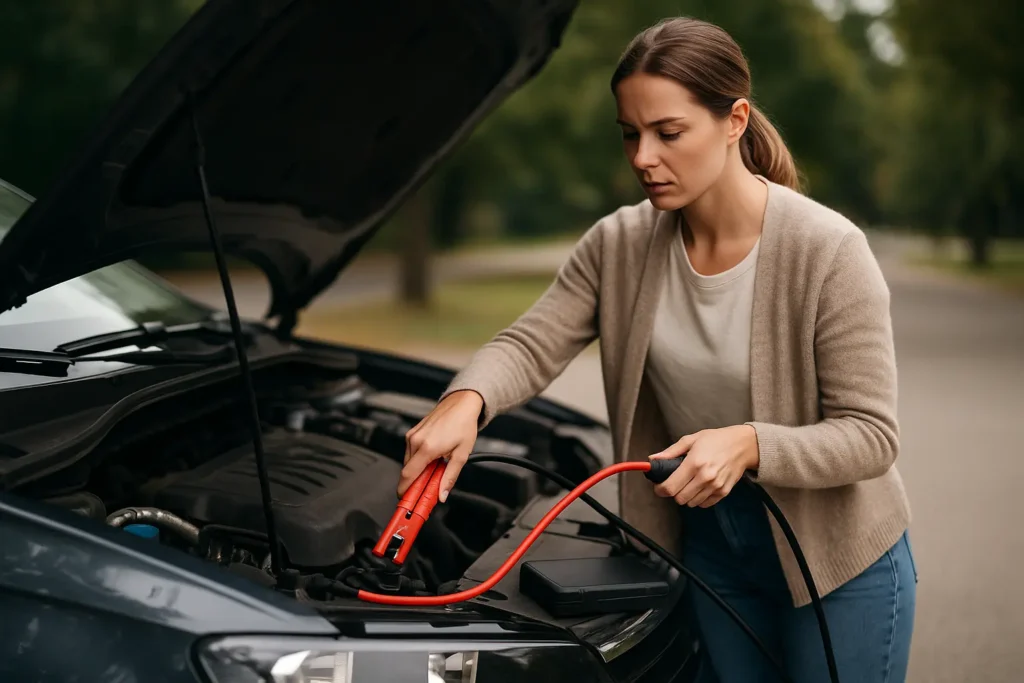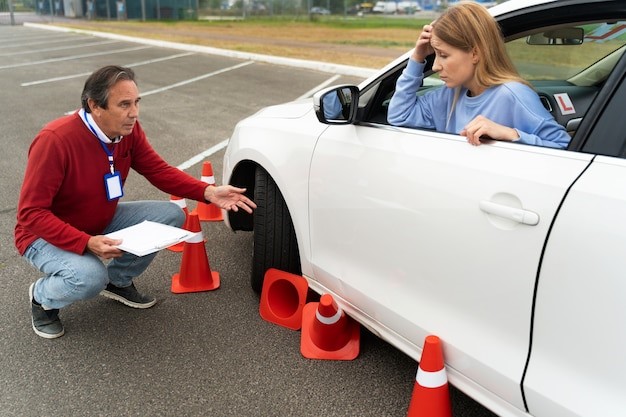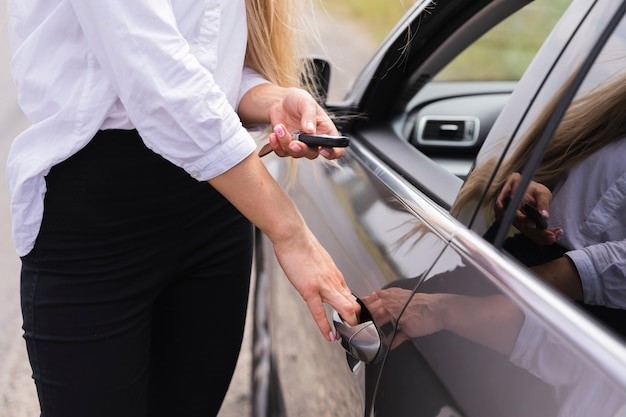When your car battery unexpectedly gives up, jumpstarting can be a real savior. Be it in your driveway or somewhere stuck in a parking lot, jump starting a car is a trick that every driver must know how to do safely. The guide has been narrowed down to suit beginners with each step explained in a simple and easy to understand way. The highest priority is safety, and it can be ensured by knowing the correct tools, methods, and precautions that may help avoid injuries or electrical system damage to your car. This blog explores how to jumpstart a car safely with step-by-step guide for beginners.
Jumpstarting a car refers to the process of temporarily wiring a dead battery to a good one or to a power outlet in order to supply adequate electrical current to crank the engine. Safety is of uttermost importance when doing this procedure since automotive batteries are high voltage and handling the cables carelessly may cause sparks, short circuits or in worse cases explosions of the battery. Correct procedure sees to it that the car ignites without causing harm to yourself or any electrical damage.
Step-by-Step Instructions How to Jumpstart a Car Safely
Step 1 – Position the Vehicles Properly
Get the donor car as near as possible to the dead car, within jumper cable reach of both batteries. Both cars should be parked in neutral or park (automatic), with the engines turned off. Apply parking brakes in both vehicles to avoid any movement in the process. Open the hoods of the two cars and find the batteries.
Step 2 – Turn Off the Ignitions and Set the Parking Brakes
Make sure that both cars are fully switched off, lights, radios, and accessories. This helps to avoid electrical surges upon connecting. Ensure parking brakes are applied to ensure stability of the vehicles.
Step 3 – Connect Jumper Cables in the Correct Order

When connecting the cables, it is necessary to follow a certain sequence in order to prevent short circuit or sparks:
- Positive (Red) Clamp to Dead Battery: Connect one red (positive) clamp to the positive terminal ( + ) of the dead battery. Ensure that the connection is well closed and that the clamp does not Rest on other metal components.
- Positive Clamp to Donor Battery: Connect the other red (positive) clamp to the positive post of the donor battery.
- Negative Clamp to Donor Battery: Attachment of the clamps Connect one black (negative) clamp to the negative terminal (-) of the donor battery.
- Negative Clamp to Ground on Dead Vehicle: Connect the last black (negative) clamp to an unpainted metal surface on the engine block or chassis of the dead car that is grounded. Do not put it close to the battery to reduce the possibility of sparks.
Step 4 – Start the Working Car First
Once the donor vehicle is started, allow it to run between 2 to 3 minutes. This enables the alternator to start delivering charge to the flat battery. A little revving of the engine (not too much) may be used to provide a more powerful current.
Step 5 – Start the Dead Car Carefully
Attempt to crank the car using the dead battery. It may not start immediately, in which case wait a minute or two and then try. In case it does not start, check your cables again. When everything is connected properly and still it does not start, there is a possibility that the battery is very damaged or another part as well.
Step 6 – Remove the Cables Safely in Reverse Order
After the dead vehicle has started, start disconnecting the jumper cables in reverse order of how they were attached:
- Take off the black clamp on the grounded metal of the dead vehicle.
- Disconnect the negative terminal of the donor car by removing the black clamp.
- Disconnect the positive terminal of the donor vehicle by removing the red clamp.
- Take the red clamp off of the battery that was dead. Be careful to avoid letting the clamps contact one another, or any metal, in removal.
Step 7 – Let the Engine Run for 10–15 Minutes
Allow the vehicle that has been started again to idle for a minimum of 1015 minutes to allow the alternator to charge the battery. Ideally, take the vehicle around a 20 to 30 minutes’ drive to enable the battery recharge to adequate status. Do not switch off the engine at once.
Tools You Need to Jumpstart a Car Safely
Jumper Cables or Portable Jump Starter: A good pair of jumper cables will also be required, preferably 10-12 feet long and with a gauge rating of 4-6. Otherwise, a portable jump starter is a self-contained power source that is particularly convenient when there is no second car around.
Safety Glasses and Gloves: These will guard against inadvertent sparks or battery acid spills. Though not compulsory they are strongly advised to ensure safe handling.
A Running Vehicle or Power Pack: Unless you have a portable jump starter, you will also require another vehicle with a fully charged battery that will act as the power donor.
Safety Tips When Jumpstarting a Car

What to Avoid During a Car Jumpstart
- Always keep jumper cable clamps from touching.
- Never jump start a frozen or leaking battery.
- Do not hold your face over the battery.
- Never try to jumpstart around open flames or cigarettes.
Signs You Should Not Attempt a Jumpstart Yourself
- Battery appears swollen or leaking acid.
- You smell a strong sulfur or rotten egg odor (a sign of battery failure).
- The car shows signs of deeper electrical problems such as flickering dashboard lights.
In these cases, it’s best to call a professional roadside assistance service.
Common Mistakes People Make When Jumpstarting a Car
Reversing the Cables: It can also lead to a short-circuit of the battery and its permanent damage when the red clamp is connected to the negative terminal or vice versa.
Skipping Safety Checks: Jumpstarting without checking the battery whether it has cracks or corrosion may cause an injury or a fire.
Touching Clamps Together: This may cause dangerous sparks, and there is a great possibility of electric shock or battery damages.
Final Thoughts
How to Jumpstart a Car Safely: Learning to jumpstart a car the safe way will save you time, stress and money. Such an important skill can not only save you long hours of waiting to get assistance but you can also use it to assist others. Nevertheless, be safe at all costs and do not do anything you do not know or are not comfortable with.
All 4 One Transportation Service is a company that deals with professional jumpstarts, towing, and roadside assistance in Allenhurst and its neighbors. You can call us anytime you are unsure of something or just need some urgent assistance. We can be dispatched to get you back on the road in the shortest time possible safely. believe in the professionals available round the clock to help in case of vehicle emergency.
FAQs
Yes, when it is not properly done. Backwards cables or surges will make harm to the vehicle computer system.
An occasional jumpstart is not a problem but frequent jumps indicate that the battery or alternator is going bad.
Yes, when it is done with due care. Cables should be kept dry and standing water should be avoided.




